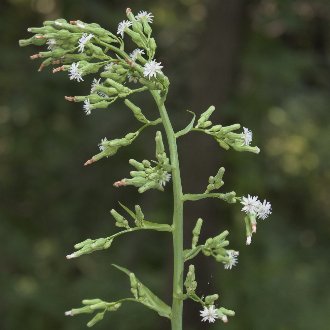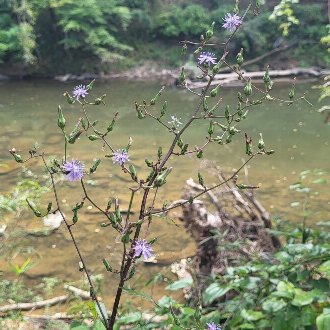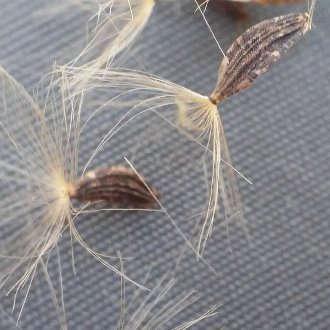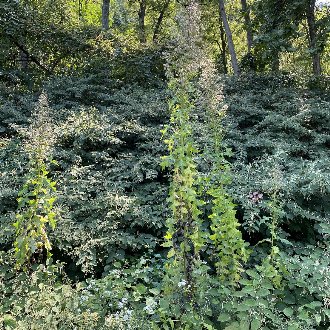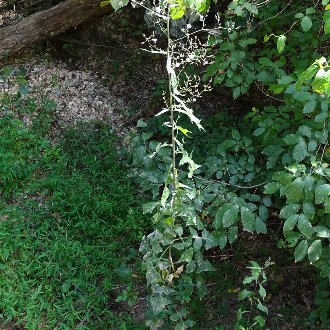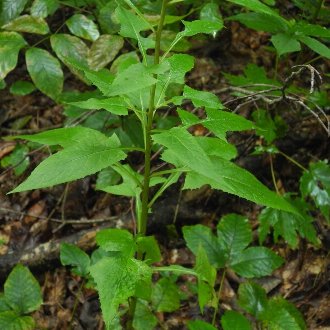Tall Blue Lettuce vs Woodland Lettuce
These species are easily confused in the limited zone in which their ranges overlap. They can usually be distinguished by differences in flower size and seeds. They have differences in leaf shape and bloom time, but with some overlap in both characteristics. Both tend to grow in partly-shaded, moist, disturbed habitats in rich soils, and for the most part, L. biennis is the more northerly species occupying a similar niche as L. floridana, the more southerly species, but L. floridana ranges farther north in the central US, and L. biennis is also found in the West. Where they overlap, L. floridana tends to prefer shadier, moister, and slightly less disturbed habitats than L. biennis.
Tall Blue Lettuce (Lactuca biennis) | Woodland Lettuce (Lactuca floridana) |
A tall biennial native to the more northerly parts of North America. | A tall biennial native to the southeastern to central US. |
Flowerheads smaller, more inconspicuous, but averages with more rays (usually 20-30, sometimes 15-50+). Color ranges from pale blue to white, rarely yellow, averages a paler color. Photo © bobkennedy, CC BY-SA 4.0. | Flowerheads larger, showier, but averages with fewer rays (usually 10–15, sometimes to 25+). Color ranges from blue to whitish, but averages a deeper blue, slightly more purplish. Photo © Ken Kneidel, Public Domain. |
Inflorescence is denser and more compact, usually with 20-30 flowerheads, rarely as few as 15 or as many as 50 or more. Photo © aarongunnar, CC BY 4.0. | Inflorescence is sparser and more spreading, usually with 10-15 total flowerheads, rarely 25 or more. Photo © Jeff Wilson, CC BY 4.0. |
Pappus (wispy part that carries seed away in the wind) is attached to seed bodies by a beak so short (<0.5 mm) that it is does not appear like a separate stem. Pappus is grayish, tan, or light brown. Photo © Étienne Lacroix-Carignan, Public Domain. | Pappus is attached to seed bodies by a stout beak (like a small stem) that is short (to about 1/3rd the length of the seed body) but still usually distinctly visible. Pappus is bright white. Photo © botanygirl, CC BY 4.0. |
Plants can be much taller, frequently to 200cm / 6.5ft, occasionally to 300cm / 9.8ft or even taller. Plants are rarely shorter than 75cm / 2.5ft at maturity. Photo © Mason Heberling, CC BY 4.0. | Plants average shorter, commonly as short as 25cm (less than 1 foot), and usually not more than 150cm / 5 feet, only very rarely more than 200cm / 6.5 feet. Photo © Samantha Heller, CC BY 4.0. |
Leaf shape variable, but when leaves are lobed, leaves usually have more larger lobes distributed evenly throughout the leaf; front lobe is not usually much bigger than other lobes. Lobes often extend closer to the leaf base. Photo © Mark, CC BY 4.0. | Leaf shape variable, but leaves are more likely to have a large triangular or lanceolate front lobe with no other lobes, or only a few much smaller lobes. The base of each leaf is often narrow and devoid of lobes. Photo © mjpapay, CC BY 4.0. |
Additional Notes
The traits of both of these species are highly variable and it is important to consult multiple characteristics. It is often easier to identify these species if you know the characteristics of local populations.References & External Resources
These short lists show only links helpful for ID. For a complete list of references and resources also covering other aspects of ecology, visit the links section of the full article on each plant, which is the first entry here.





